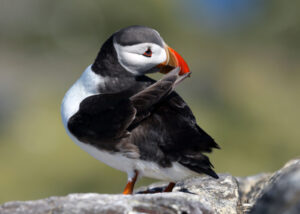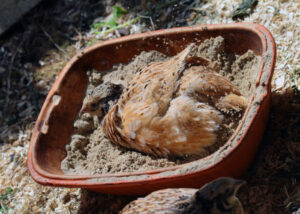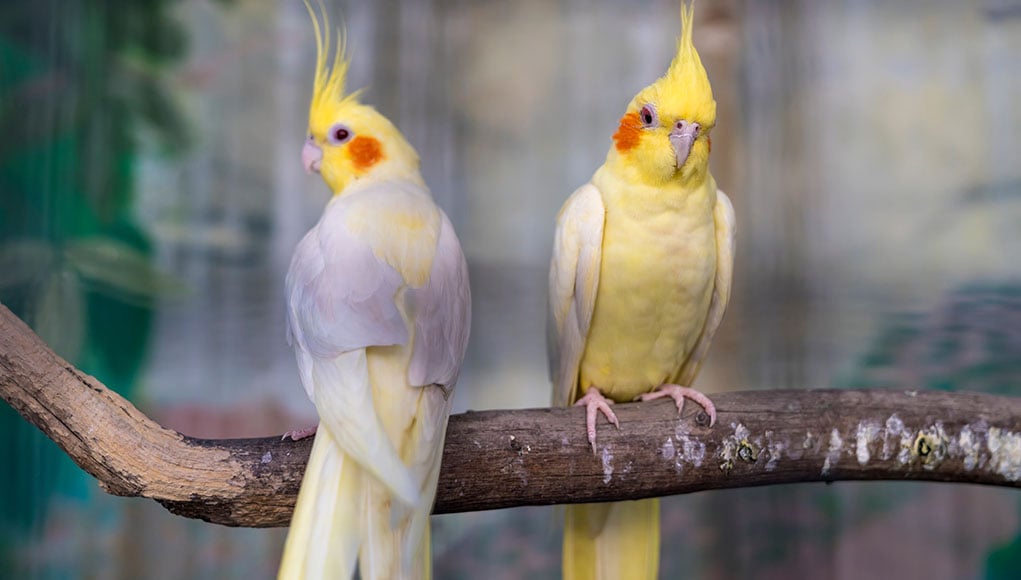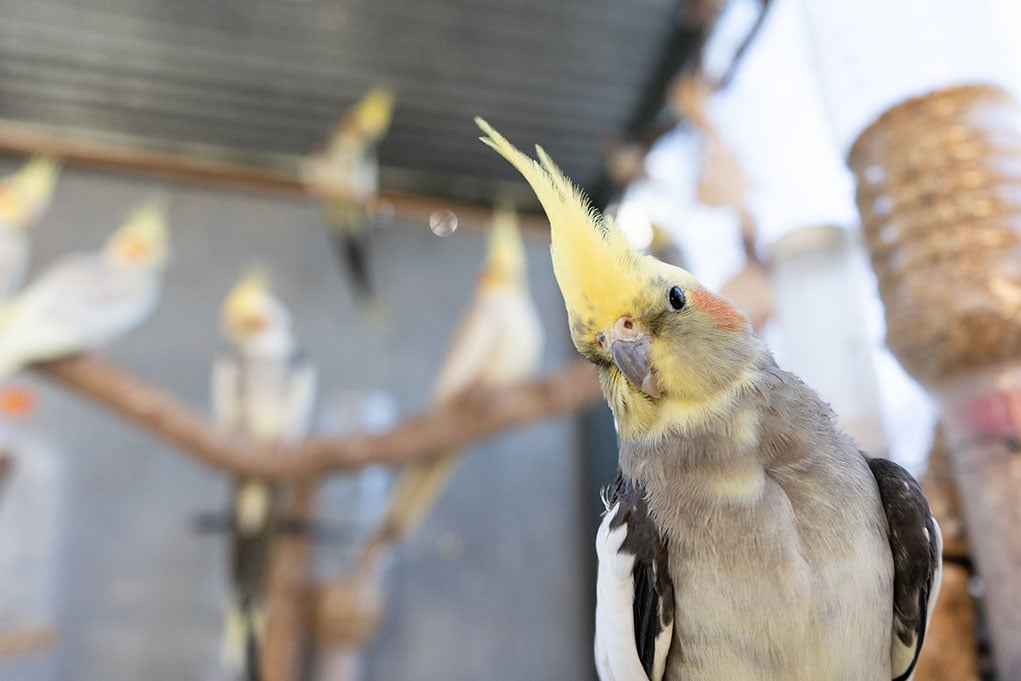When you have a pet bird,it’s important to understand their grooming habits.
Birds are some of the cleanest creatures out there – they devote much time to preening and grooming themselves.
This helps them to keep their feathers in good condition and stay healthy.
As a bird parent, it’s important to understand your pet’s cleaning habits so that you can help them maintain optimal health.
In this blog post, we’ll share some tips and insights on understanding your feathered friend’sprimping and preening habits.
Who knows, you may be inspired to upgrade your own self-care routine, too!
Primping and Preening Birds
鸟爱好者,我们可能会注意到有羽毛的朋友s engaging in a behavior called “primping and preening.”
This behavior isessential for maintaining the health and well-beingof the birds and their feathers.
Let’s take a closer look at what exactly this means.
What is the “Primping and Preening” Behavior?
Preening behavior is the act of birds using their beak to clean and maintain their feathers.
It is an essential activity that helps birds remove dirt, dust, andparasites from their feathers.
This behavior is vital for birds to keep their feathers in top condition, which is essential for flying and staying warm.
Why Do Birds Preen?
So what makes birds engage in this behavior – and what are its benefits? Let’s take a closer look.
1. Moisturizing
Moisturizing is an essential function of preening, particularly for aquatic birds.
These birds’ feathers come into close contact with water, which can strip their natural oils and make them more prone to damage.
Therefore, preening functions as a way to spread natural oils along the length of their feathers, keeping them moisturized and healthy.
2. Protection
Feathers are critical for birds’ survival, playing a vital role in their insulation, flight, and camouflage.
Preening allows birds to smooth their feathers, remove debris, and create a protective layer to help shield their bodies from outside elements.
3. Efficiency
Each feather has tiny fibers that overlap and form a tight seal.
This tight seal improves its aerodynamic stability and helps birds regulate their body temperature.
Preening helps align these fibers, which enables wings to move efficiently and increases thermal insulation, allowing them to retain more body heat and survive in colder weather.
4. Health and Well-Being
Many birds catch lice and mites, leading to significant discomfort and possible infections.
The birds, through preening, attempt to rid themselves of any biting insects on their bodies and to ensure they remain clean and hygienic, thereby reducing any risks of infections in their feathers.
5. Gets Feathers Into Proper Position
The proper alignment of feathers enhances the bird’s appearance, making it more attractive to potential mates or in communication with other birds.
Some birds may even add decorative touches to their feathers through preening, such as adding iridescent colors or shapes to communicate their territorial defense.
6. Mating
The quality of a bird’s feathers is a crucial factor in attracting a mate.
Clean, well-maintained feathers demonstrate that a bird is healthy and capable of caring for itself.
During the breeding season, male birds will often preen excessively to ensure their feathers are in top condition.
This helps them attract a female mate who is looking for a healthy partner to breed with.
7. Communicating
Birds are social creatures that rely on communication to survive. And preening is an essential aspect of communication among birds.
When birds preen, they secrete oil from a gland near their tail, which they use to condition their feathers.
The oil makes their feathers waterproof and helps them fly efficiently.
In addition, birds preen as a way of establishing social bonds.
Birds that are closely related or mate for life will often preen each other as a way of showing affection and strengthening their bond.
What’s the Difference Between Plucking and Preening?
Plucking is a behavior where a birdpulls out its own feathers, causing bald spots.
This behavior is often a sign of a problem, such as physical discomfort or stress.
On the other hand, preening is a behavior where a bird cleans its feathers and arranges them using its bill.
Preening helps maintain the feathers’ structure and keeps them waterproof and insulating.
In this way, preening is an essential behavior for birds’ survival in the wild.
How Do Birds Learn to Preen?
Preening is an instinctive behavior that birds have from birth.
Baby birds learn from their parents and other birds in their flock how to preen themselves correctly.
Preening is a social behavior that birds learn by observing and imitating adult birds’ behavior.
Young birds will often watch their parents and try to copy them as they learn how to maintain their feathers properly.
Do Birds Preen When They Are Happy?
Birds often preen after social interactions or when they are relaxed and content.
Preening helps birds alleviate tension and stress and allows them to relax in their surroundings.
In this way, preening can be considered a sign of happiness in birds.
However, birds can also preen when they are anxious or stressed, so the behavior alone is not a reliable indicator of a bird’s mood.
How Exactly Do Birds Preen?
Are you curious about what preening behavior looks like?
Here are a few ways birds preen so you won’t be caught off guard next time you see it happening!
1. Dust Bathing
One of the ways birds clean their feathers is bydust bathing.
This behavior is common in ground-dwelling birds like chickens and quails.
In this process, birds dig a shallow hole, lie on their sides, and flap their wings, creating a cloud of dust that coats their feathers.
The dry dust settles onto the feathers and absorbs excess oil, dirt, and parasites.
After a good dust bath, birds will preen their feathers to remove the dust and ensure they lay flat.
2. Sunning
Birds also use the sun to clean their feathers and kill parasites.
Sunning is prevalent in small passerine birds that can bask in the early morning or late afternoon sun, depending on the temperature.
This behavior is especially important for birds living in humid areas, where parasites, such asmites and lice, are a common problem.
Birds will often spread their wings and tails to maximize the sun’s exposure on their feathers, helping to get rid of unwanted visitors.
3. Bathing
Birds will regularly bathe in shallow pools of water, like bird baths, to remove dirt and parasites.
Some birds are efficient bathers, quickly dunking their bodies and shaking off excess water.
Other birds, especially ducks, and waterfowl, will spend more time in the water and use their beaks to spread oil over their feathers, making them more waterproof.
After bathing, birds will dry their feathers and preen to remove any remaining debris.
4. Stretching
By stretching their wings, birds can loosen up feather muscles,promoting blood circulationand flexibility.
This behavior is especially important forbirds that flylong distances or have wings with high maneuverability needs, such as raptors.
Stretching can also help prepare birds for flight by warming up their muscles, allowing them to fly for longer periods without getting tired.
5. Anting
Anting is when birds pick up ants or other insects and rub them on their feathers.
The reason for this is not entirely clear, but scientists have several theories.
Some believe that ants help remove parasites, while others suggest that ant secretions act as natural insecticides or even have medicinal properties.
Why Are My Birds Preening Each Other?
Preening is an essential part of a bird’s daily routine.
They use their beaks to carefully clean and realign feathers, remove dirt and debris, and spread natural oils throughout their plumage.
This process helps keep their feathers in good condition for flight and insulation, and it also helps repel water.
然而,自我夸耀我s not always a solo activity.
In fact, it’s quite common for paired birds and those in family flocks to preen one another.
This is referred to asallopreeningand serves as a means of reinforcing bonds between birds.
Not only does it keep them tidy, but it also allows for social grooming and bonding.
生病的鸟类或疼痛往往失去兴趣in grooming themselves or others as they lack the energy or motivation to do so.
A tattered-looking bird that appears unkempt and ignored by their flock may be an indication of illness or stress that needs to be addressed promptly.
But don’t worry too much about the occasional squabble over-grooming.
This is entirely normal in flock dynamics and can be a form of dominant behavior.
However, if you notice excessive or violent attempts at preening, it might be a sign of aggression or territoriality among your birds.
In such cases, you may need to intervene or consider separating the birds.
Why is My Bird Preening Aggressively?
Aggressive preening can be a cause for concern, making us wonder why our birds are behaving in such a way.
One reason why birds maystart aggressive preeningis due to molting, which is when birds shed their old feathers and replace them with new ones.
This process can be painful and cause discomfort to birds.
As a coping mechanism, birds tend to over-preen and groom themselves aggressively.
Another reason why birds may start aggressive preening is due to a lack of essential nutrients in their diet.
A poor diet can cause a bird’s feathers to become dry and brittle, leading to discomfort.
This discomfort can again result in aggressive preening.
Therefore, it’s important to ensure that your bird is being fed a balanced diet with the right nutrients.
Certain external parasites, such as mites and lice, can also cause birds to preen themselves excessively, leading to aggressive preening.
If you suspect that your bird may have external parasites, it’s important to bring them to a veterinarian for treatment.
Finally, just like humans, birds can also experience stress and anxiety, leading to aggressive preening.
Changes in their environment, lack of mental stimulation and social interaction, and fear can all contribute to stress and anxiety in birds.
Common Problems Related to Primping and Preening
Like anyone, birds can also experience some problems related to preening.
For example,over-preeningis a common problem caused by poor diet, illness, dry environment, or boredom.
During this time, a bird may seemingly be obsessively grooming itself to the point of digging into its skin or focusing too much on one feather.
The solution to over-preening is first to identify the root cause and address it.
Try changing their environment, providing better nutrition, socialization, and toys to keep them occupied.
Another issue isunder-preening.
Under-preening happens when a bird doesn’t appear to be taking an interest in the activity, and the coat begins to look tattered and unkempt.
It could be caused by a health issue such as arthritis or limping.
The solution would be to take the bird to a vet, who will conduct tests and provide a diagnosis.
Finally, remember that althoughfeather pluckingmay seem like preening, it’s actually a more severe issue.
A bird may pluck its feathers out of frustration, fear, or inappropriate living conditions.
A visit to the vet is, therefore, needed to address medical conditions, while environmental changes such as better socialization and attention can reduce feather plucking in pets.
How You Can Encourage Healthy Primping and Preening in Your Pet Bird
Preening habits not only help your bird maintain its feathers, but they also improve its overall health and well-being.
As abird owner, it’s essential to encourage healthy preening habits in your pet bird to ensure that it stays healthy and happy.
Here are some tips.
1. Offer a Varied Diet
A bird’s dietplays a significant role in their feather health.
Providing a balanced and varied diet of fruits, vegetables, pellets, and seeds can help prevent nutrient deficiencies, which can lead to feather damage.
For example, a lack of vitamin A can cause dry, flaky skin and brittle feathers.
On the other hand, a diet high in fat can lead to obesity and affect feather quality.
It’s essential to consult your veterinarian to design a suitable diet plan for your bird’s specific needs.
2. Provide Bathing Opportunities
Bathing plays a crucial role in a bird’s preening habits.
The bath helps to moisturize the skin and feathers, making preening easier.
Different birds have different preferences in how they like to bathe.
Some birds enjoy a shallow dish of water, while others prefer a spray bath.
Still, others would rather have access to a dust bath.
Whatever the case may be, providing a daily bath or a bath a couple of times a week, depending on the bird’s preference, can encourage healthy preening behaviors.
3. Offer Toys and Perches
Birds love toys, and having the right toys and perches can encourage them to preen naturally.
Providing a variety of toys with different textures and materials can stimulate your bird’s preening behavior.
Some birds like to preen onspecific perches, such as natural wood, rough, or sandy perches.
提供各种安全、合适的栖息他能lp your bird maintain healthy preening habits.
4. Monitor for Feather-Damaging Behaviors
Birds can develop feather-damaging behaviors, such as excessive preening, plucking, or barbering.
These behaviors can lead tofeather loss and damage.
If you notice any behavior issues, it’s essential to address them immediately.
Feather-damaging behaviors can be caused by many factors, such as stress, boredom, or medical issues.
A veterinarian can help identify and treat the underlying cause of this issue, but you’ll want to remain vigilant to prevent it from happening.
5. Provide a Stress-Free Environment
A stress-free environment is crucial for maintaining healthy preening habits in birds.
Stress can trigger feather-damaging behaviors, such as plucking or barbering.
Providing a regular routine, plenty of socialization, and mental stimulation can help reduce stress in birds.
Avoiding noisy or chaotic environments, as well as ensuring thebird has access to quality sleep, can also be helpful in maintaining a stress-free environment.
Primping and Preening Birds: Final Thoughts
Birds are some of the cleanest creatures out there, and how they groom themselves plays a vital role in theiroverall health and well-being.
By understanding your feathered friend’s primping and preening habits, you can ensure you’re doing everything possible to help maintain their health.
Grooming habits like feather plucking, bathing, and beak sharpening are crucial to your bird’s overall well-being.
Make sure your bird always has access to toys to keep their grooming habits in check, which will aid both their mental and physical health.
Grooming can be tiresome for yourpet bird, so be sure to keep an eye out and lend a helping hand to your feathered friend whenever they need it.
No expensive salon visit is necessary – just follow the tips above, and your birds will stay healthy and happy as can be.
Interested to learn more about bird care and their behavior? Check out our recommended articles below!







